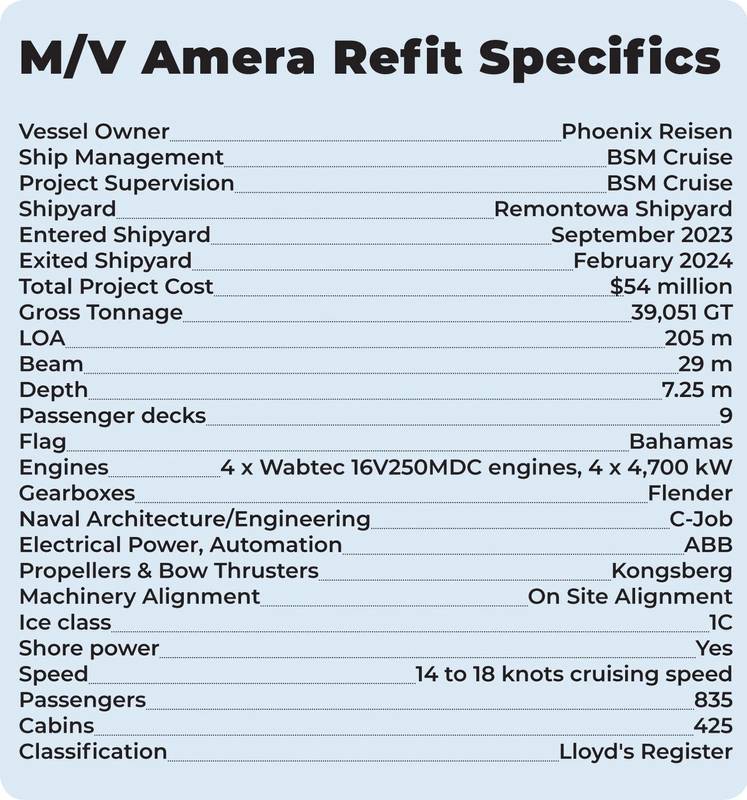Cruise Vessel MS Amera Gets a New Lease on Life
Shipowners in all sectors face the same decision: build new or refurbish older tonnage. In the booming cruise sector the decision is more pressing, particularly as new construction ships can take two to three years to build, perhaps longer today with global shipyard orderbooks packed full.
When the decision was taken to upgrade the nearly 40-year-old MS Amera, trust for the project landed with BSM Cruise, the technical ship manager of MS Amera, and Wabtec channel partner VMS Group, charged with providing a modern power package to propel the ship for a new generation of cruise ship passengers.
The ship was built in 1988 as Royal Viking Sun at Wärtsilä-Marine-Perno shipyard in Turku, Finland, and operated from 2000 as Seabourn Sun; from 2002 as Prinsendam; and since 2019 as Amera, sailing for the German cruise operator Phoenix Reisen. Throughout its career it has received regular upgrades, conversions and renovations, most recently at the end of 2023/beginning of 2024 at Remontowa Shipyard in Gdansk, Poland.
Tim Mass, Technical Superintendent, BSM Cruise since 2018 and a long-tenured maritime professional, was responsible for the conversion and retrofitting of Amera, including the Tier III engine upgrade, steel construction, IT and hotel technical modifications.
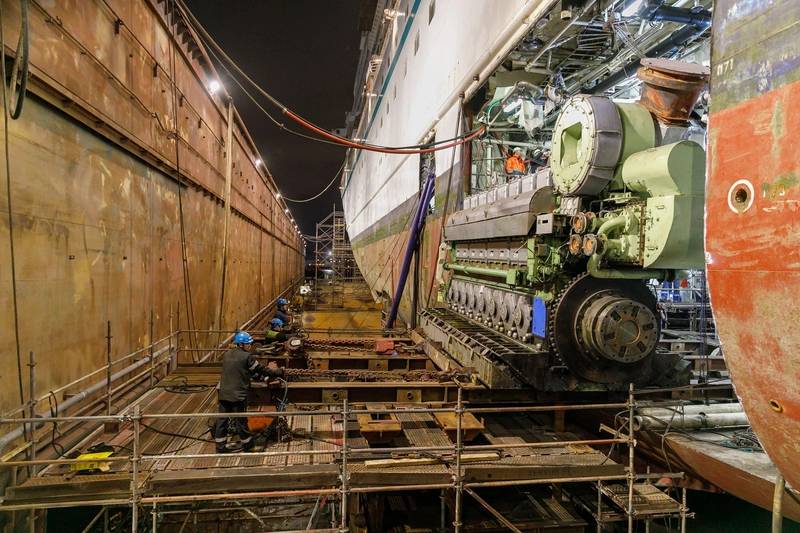 Removal of one of the old main engines via an port side hull hole. Copyright Phoenix Reisen / BSM Cruise
Removal of one of the old main engines via an port side hull hole. Copyright Phoenix Reisen / BSM Cruise
Fit for Refit
Tightening emission reduction regulation globally is the primary driver today for shipbuilding and refit projects, from tugboats to tankers and every sector in between. According to Mass, the conversion and refit of Amera followed this formula, driven by regulation and sustainability aspirations of its owner. Also, the ship was to be upgraded in terms of technology (replacing obsolete machinery like gearboxes) and comfort.
“Phoenix Reisen is constantly investing in the renewal and improvement of its fleet,” said Mass. “Phoenix Reisen relies on traditional cruise tonnage because these ships fit perfectly into the portfolio and suit the taste of the Phoenix cruise customers. BSM Cruise started the first project phase in 2020 by determining different technical options to meet the requirements.”
In 2021, the contracts were signed with VMS for four Wabtec main engines and two Flender gearboxes, and at the end of September 2023, the ship entered drydock at Remontowa Shipyard in Gdansk, Poland. In addition to the aforementioned suppliers, other major contributors in the project included C-Job; ABB; Kongsberg; and On Site Alignment.
While the biggest part of the project was the completely new engine setup, featuring the high-efficiency main engines and advanced exhaust gas recirculation technology, critical too were the new generators and electrical power solutions, new bow thrusters, the addition of a shore power system and a new antifouling hull coating.
The ship's previous four main engines and three auxiliary engines of the ship were removed and replaced with four new Wabtec 16V250MDC engines.
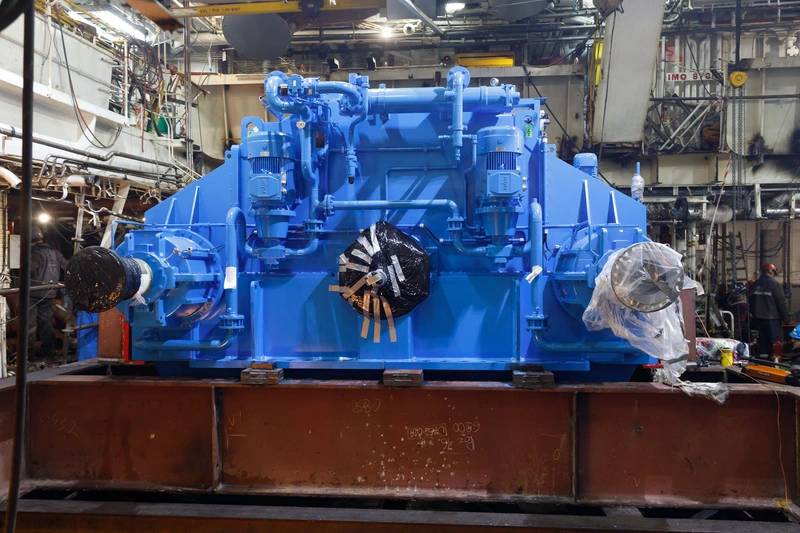 One of the new Flender gearboxes.
One of the new Flender gearboxes.
Copyright BSM Cruise
“MS Amera will be repowered with the cleanest diesel engines available,” said Patrick Webb, Senior Director – Global Sales, Marine & Stationary, Wabtec. “After all these years of faithful service, the four Wärtsilä – Sulzer Marine Diesel Engines have been replaced with the most innovative clean engine solutions in the world. The four Wabtec 16V250MDC Dual compliant (EPA Tier 4 and IMO Tier III) Simply Clean Marine Diesel Engines make this older lady one of the cleanest cruise ships in the world. These low emission engines take advantage of breakthrough technology design (originally funded by General Electric) and now owned by Wabtec Corporation. These engines are best-in-class clean, quiet, and fuel efficient with no need for any after-treatment, Dox Cabinets, Scrubbers, DP Filters, nor SCR systems. With this simple plug and play solution, the MS Amera was able to receive a full repower with no need for urea tanks or any other space absorbing systems.”
According to Mass, the new main engines are connected on one side of the crankshaft via a clutch and gearbox to the propeller for propulsion and on the other side of the crankshaft to an alternator for electric power production. “With this setup there is no need any more for auxiliary engines and the main engines can be operated in optimized load ranges,” said Mass. “Each main engine has 16 cylinders with a cylinder size of 250 mm operating at 1,000 rpm. The rated power per engine is 4,700 kW given a total power of 18,800 kW to the ship.”
Key to the selection of Wabtec power was the fact that the exhaust recirculation system ensures compliance with the IMO TIER III requirements without the need of an SCR system and have no urea consumption, said Mass.
Energy efficiency extends down the powertrain. For example, the two new bow thrusters from Kongsberg have a power rating of 1,033 kW each. “The thrusters are differently designed compared to the previous ones as they are fixed pitch and variable speed – previous ones were fixed speed and variable pitch,” said Mass. “This allows a reduction in power consumption because the thrusters are only running when they are operated. In standby mode they are not rotating, and therefore don’t consume any energy.”
In addition, a new DC switchboard together with new alternators, transformers, bow thruster electric motors, and the new shore power connection system were supplied by ABB.
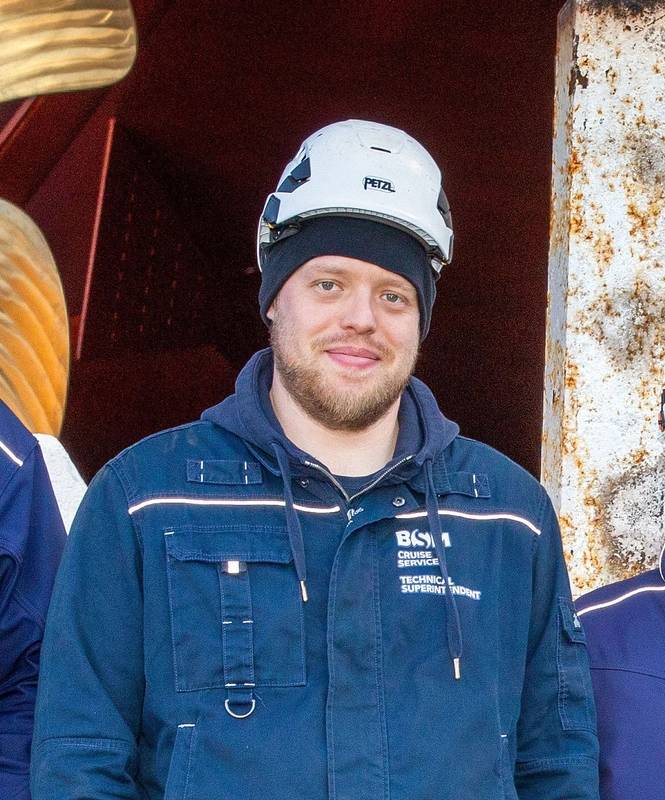 “Most other next-generation power solutions that could have been considered require an SCR system. This was not an option for the Amera for construction reasons, as this would have required a new exhaust system and urea storage. The solution from Wabtec is based on an exhaust gas recirculation system. We have already had good experience with such solutions from Wabtec, for example with smaller versions of auxiliary diesel engines on the Amadea. An alternative fuel refit would have not been possible due to space limitations.”
“Most other next-generation power solutions that could have been considered require an SCR system. This was not an option for the Amera for construction reasons, as this would have required a new exhaust system and urea storage. The solution from Wabtec is based on an exhaust gas recirculation system. We have already had good experience with such solutions from Wabtec, for example with smaller versions of auxiliary diesel engines on the Amadea. An alternative fuel refit would have not been possible due to space limitations.”
– Tim Mass, Technical Superintendent, BSM Cruise
The Power Package
Selecting the powerplant is always a critical choice in a newbuild or conversion project, and Mass explained the rationale for the move to Wabtec.
“Most other next-generation power solutions that could have been considered require an SCR system. This was not an option for the Amera for construction reasons, as this would have required a new exhaust system and urea storage. The solution from Wabtec is based on an exhaust gas recirculation system. We have already had good experience with such solutions from Wabtec, for example with smaller versions of auxiliary diesel engines on the Amadea. An alternative fuel refit would have not been possible due to space limitations.”
Prior to the refit, the ship was equipped with four main engines which were used for main propulsion and could supply via two shaft generators electric powers for the bow thrusters during maneuvering. All other electric load was supplied via three auxiliary engines. Propulsion was completed via two variable pitch propellers where each was driven by two main engines via a double in/single out reduction gear. All electric load was distributed via a 6.6kV AC main switchboard from which the two bow thrusters and the three air condition chiller units were directly fed. All other ship electrical consumers were supplied via 440V and 230V switchboards. The two bow thrusters were fixed speed variable pitch thrusters.
“After the refit, the ship now has four main engines which have fixed coupled generators which produce 780V AC,” said Mass. “On the other side of the engines, they are connected via a clutch to two double in/single out gearboxes which drive the two variable pitch propellers. There are no more auxiliary engines installed. The electric load is now distributed via a 1000V DC switchboard which directly supplies variable frequency to the bow thrusters and chillers. The rest of the ships consumers is still supplied via the original 440V and 230V switchboards. The bow thrusters are now fixed pitch variable speed.”
In addition, the ship has been refit with a 6.6kV shore connection which can, due to the DC main switchboard, be operated at 50 or 60Hz.
“With the new setup we are achieving significantly more efficient and environmentally friendly ship operations in compliance with IMO Tier III regulations: less fuel consumption (10 to 15% expected), less NOx emissions (approx. 90%), optimized engine layout, more efficient electrical design (DC main switchboard), shore power system, and a low-friction hull coating,” said Mass.
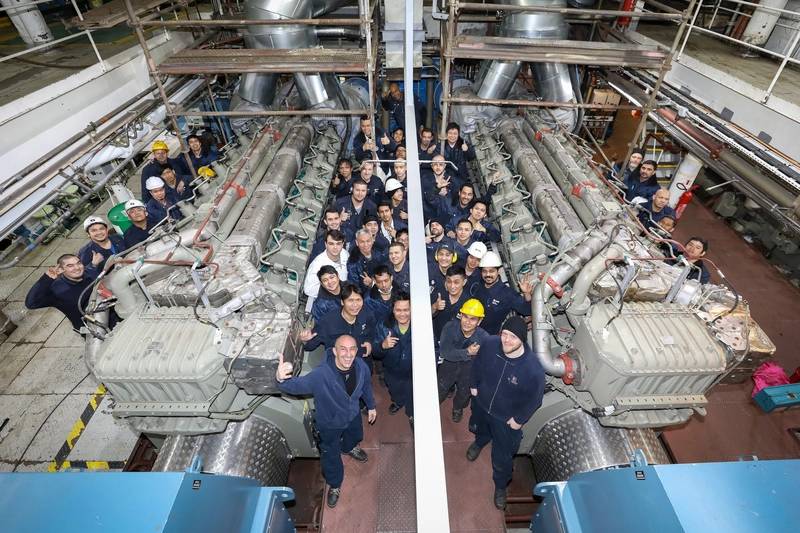 Engine room showing two of the four new main engines and the engine crew of the “Amera” (Tim Mass, front right).
Engine room showing two of the four new main engines and the engine crew of the “Amera” (Tim Mass, front right).
Copyright BSM Cruise
Meeting Challenges Head On
Anyone that has engaged in an extensive ship refit project knows that challenges abound, particularly with the integration of extensive new machinery and power systems.
“A particular challenge was the coordination of so many different technical teams,” said Mass. “After all, not only the main engines were renewed, but all auxiliary systems were also touched and converted. A lot of systems had to be integrated and aligned with one another.”
Another challenge was tougher to control: Mother Nature.
“The weather conditions were challenging as we faced a very cold and snowy winter in Poland – not ideal for a hull coating. You have to be patient.”
With that, Mass offers a few bits of salient advice for anyone mulling an extensive conversion project. “Take your time in planning and don’t trust the original drawings. We experienced a few surprises. Only believe what you have seen, measured and verified yourself. An older design can have good prerequisites, but you have to look very closely, if you want to combine the old with the new.”
Upon completion, MS Amera started again a worldwide itinerary, in the spring of 2024 sailing in South America, the Caribbean and North America. She will then cross the Atlantic to Europe, where to spend the rest of the year including cruises to the Atlantic Westcoast, Norway, Baltic Sea, Iceland, Greenland, Mediterranean and Canary Islands. At the beginning of 2025, Amera will go back across the Atlantic to South America.
“It is interesting that my mariner career started nearly the same year as the inception of the MS Amera,” said Webb from Wabtec. ”While she was in her design and build stage, I was in a maritime school preparing for my career launch in New York City. Certainly, as we both circumnavigated around the globe we crossed paths from time to time. With her sleek lines, the 205 meter MS Amera has maintained her youth and attractive shape better than I have! These new engines make this once grand lady a supermodel once again,” concludes Webb.
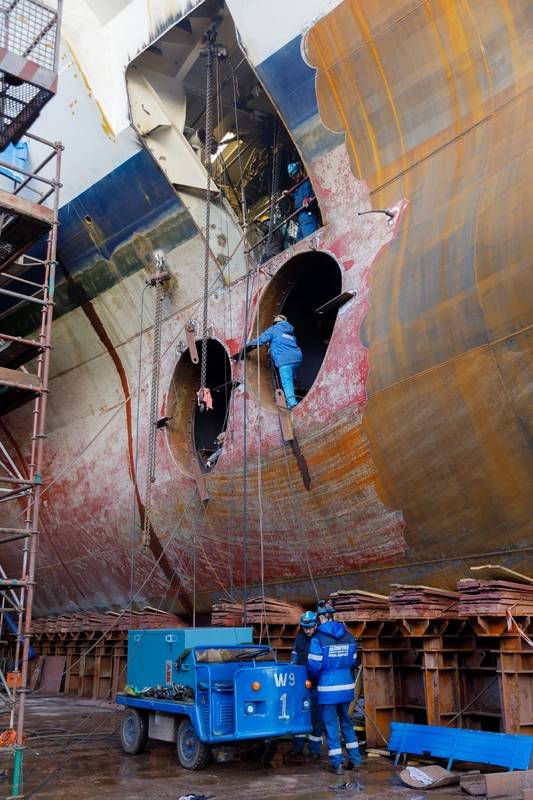 Bow thruster tunnel in which the new bow thrusters were installed
Bow thruster tunnel in which the new bow thrusters were installed
Copyright Phoenix Reisen / BSM Cruise
VMS Group: Engines, Gears & Engineering
Wabtec channel partner VMS Group combined the propulsion package consisting of four Wabtec 16V250MDC propulsion engines rated 4700 kwm @ 1000 rpm with two Flender twin-in/single out marine gears.
Wabtec L/V250 series diesel engine with the unique EGR technology meet EPA Tier 4 and IMO´s tier III emission standards without the use of a selective catalytic reduction (SCR) equipment or urea-based after treatment, offering also the lowest possible footprint and significant weight savings in combination with the custom built Flender marine gear designed to fit the existing foundation and hull structure with minimum steelwork for the retrofit. VMS, in cooperation with the technical team from BSM, designed and fabricated the foundations for generators, engines and gear that adapted to existing vessel foundations with minimum steel work and time savings for the shipyard during the retrofit.
The propulsion layout is complex, with the four main engines operating both as main propulsion through front PTO to gear and flywheel to shaft alternator covering the full main propulsion and the electrical power of the vessel saving three auxiliary gensets. Wabtec MDC series engines delivered with a front PTO shaft can take full load on both PTO and flywheel end which gives the advantage to position the engine best suited to the engine room layout and attached pipework like exhaust, which on this installation didn’t have the large exhaust pipes crossing the engine room.
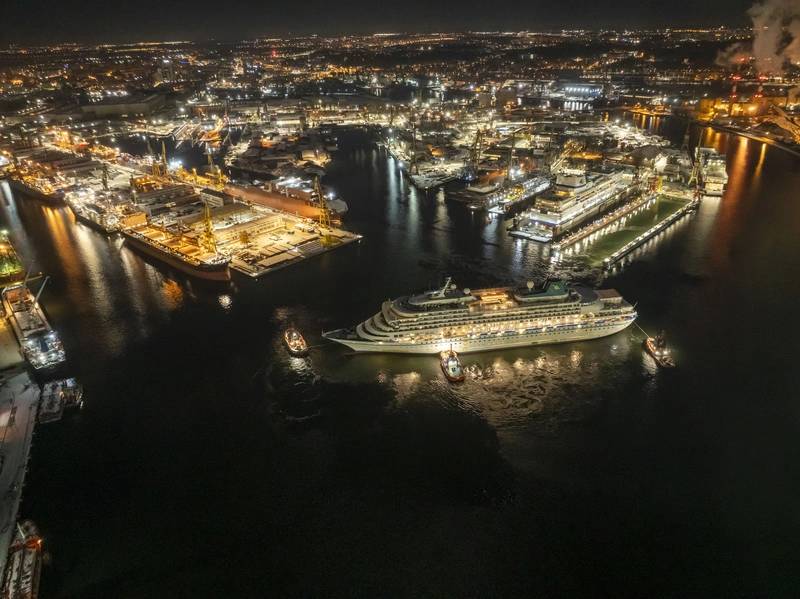 Copyright Phoenix Reisen / BSM Cruise
Copyright Phoenix Reisen / BSM Cruise
